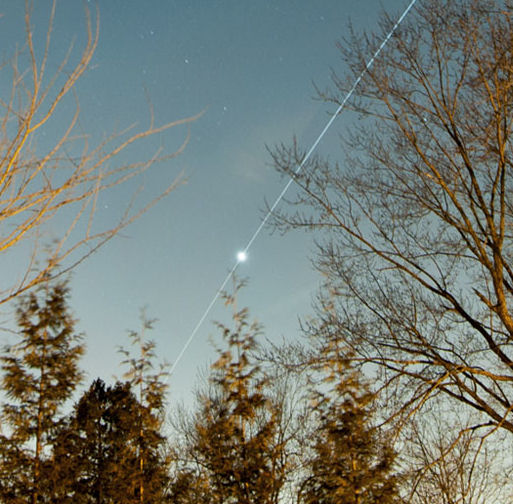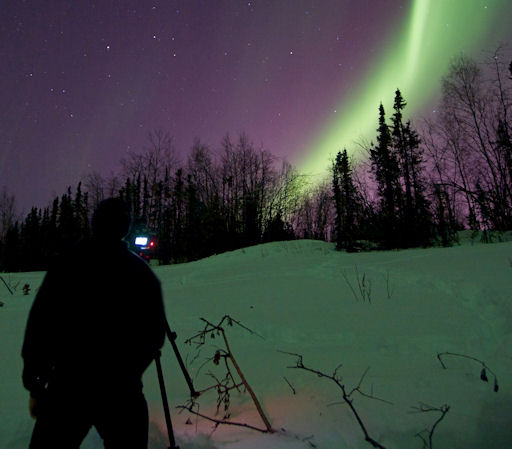QUIET OUTLOOK: The sun is peppered with sunspots, but none of them is actively flaring. Solar activity should remain low for the next 24 hours with only a slight chance of M-class solar flares. Solar flare alerts: text, voice.
ISS-VENUS ENCOUNTER: Last night, on Valentine's Eve, the International Space Station paid a visit to the Goddess of Love. "Just after sunset on on Feb. 13th, I saw the ISS pass directly in front of Venus," reports Glenn Wester, who photographed the encounter over Long Island, New York:
It could happen again tonight. The space station is making a series of bright passes over North America, zipping among the glittering stars and planets of the winter sunset sky. Local flyby times are available from SpaceWeather's Simple Satellite Tracker and Flybys App.
more images: from Malcolm Park of Cobourg, Ontario, Canada; from Robert Sparks of Tucson, Arizona
AURORA WATCH: A slight disturbance in the solar wind on Feb. 12-13 was enough to ignite auroras around the Arctic Circle. On Moose mountain, near Fairbanks Alaska, cross-country skiers Marketa Stanczykova and Ronn Murray stopped to photograph the display:
"The auroras were magical ... like always," says Stanczykova.
By all accounts, it was a good night to be out. "The sky was very clear, the moon had not yet risen, and above all it was warm: near +15!" reports LeRoy Zimmerman from Chandalar Ranch, also near Fairbanks. "There was a Japanese aurora tour on the property, and this was their first view of auroras. It is always great to be with a group of first-timers and hear the cheers and squeals as they see this wonder for the first time!" Zimmerman documented the event in a series of panoramic photos.
more images: from Lurie Belegurschi of Iceland; from Chad Blakley of Abisko National Park, Sweden; from Yuichi Takasaka of Chandalar Ranch, Two River, Alaska; from Greg Lacy on the Yukon River 150 miles from Fairbanks, Alaska; from Carlos López of Karasjok, Norway

![]()
Solar wind
speed: 379.2 km/sec
density: 0.2 protons/cm3
explanation | more data
Updated: Today at 1405 UT
![]()
X-ray Solar Flares
6-hr max: B3 1143 UT Feb14
24-hr: B3 1143 UT Feb14
explanation | more data
Updated: Today at: 1400 UT
![]()
![]()
![]()
Daily Sun: 14 Feb 12
![]()
![]()
None of the these sunspots is actively flaring. Solar activity is low. Credit: SDO/HMI
![]()
![]()
![]()
Sunspot number: 59
What is the sunspot number?
Updated 13 Feb 2012
Spotless Days
Current Stretch: 0 days
2012 total: 0 days (0%)
2011 total: 2 days (<1%)
2010 total: 51 days (14%)
2009 total: 260 days (71%)
Since 2004: 821 days
Typical Solar Min: 486 days
Updated 13 Feb 2012
The Radio Sun
10.7 cm flux: 108 sfu
explanation | more data
Updated 13 Feb 2012
![]()
![]()
![]()
Current Auroral Oval:
![]()
Switch to: Europe, USA, New Zealand, Antarctica
Credit: NOAA/POES
![]()
![]()
![]()
Planetary K-index
Now: Kp= 1 quiet
24-hr max: Kp= 3 quiet
explanation | more data
![]()
Interplanetary Mag. Field
Btotal: 6.6 nT
Bz: 6 nT south
explanation | more data
Updated: Today at 1407 UT
![]()
![]()
![]()
Coronal Holes: 14 Feb 12
![]()
![]()
Solar wind flowing from this coronal hole could reach Earth on Feb. 17-18. However, the solar wind stream is likely to sail south of our planet, making little impact. Credit: SDO/AIA.
![]()






